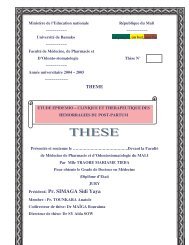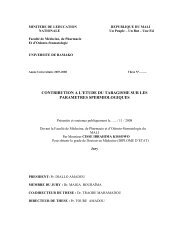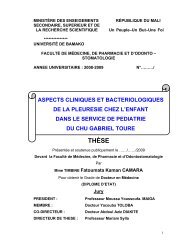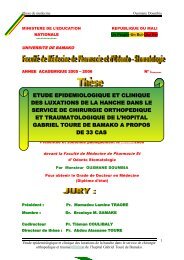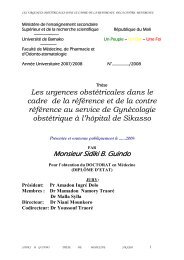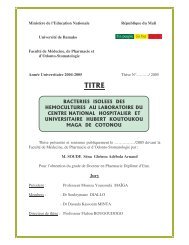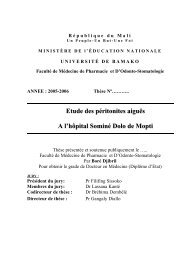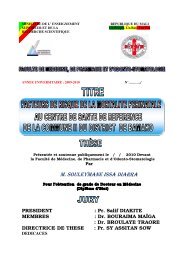SENSIBILITE DES BACTERIES PATHOGENES AUX ...
SENSIBILITE DES BACTERIES PATHOGENES AUX ...
SENSIBILITE DES BACTERIES PATHOGENES AUX ...
You also want an ePaper? Increase the reach of your titles
YUMPU automatically turns print PDFs into web optimized ePapers that Google loves.
55<br />
4.3.2. Sensibilité de Escherichia coli aux antibiotiques.<br />
Tableau VII : Profil de sensibilité aux antibiotiques testés sur Escherichia coli.<br />
Antibiotiques<br />
Nombre de<br />
souches testées<br />
Nombre de<br />
souches sensibles<br />
Nombre de<br />
souches<br />
intermédiaires<br />
Nombre de<br />
souches résistantes<br />
N % N % N %<br />
Ampicilline 24 5 20,83 3 12,50 16 66,67<br />
Amoxicilline+ac clav 21 10 47,62 9 42,86 2 9,52<br />
Gentamicine 21 15 71,42 5 23,81 1 4,77<br />
Cotrimoxazole 22 12 54,54 5 22,73 5 22,73<br />
Ciprofloxacine 24 16 66,67 0 00,00 8 33,33<br />
Kanamycine 23 17 73,91 4 17,40 2 8,69<br />
Ofloxacine 10 6 60,00 0 00,00 4 40,00<br />
Imipénème 17 17 100,00 0 00,00 0 00,00<br />
Céfalotine 24 10 41,67 8 33,33 6 25,00<br />
Péfloxacine 24 17 70,83 0 00,00 7 29,17<br />
Les antibiotiques les actifs étaient : l’imipénème (100 %), la kanamycine (73,91 %) et la gentamycine (71,42 %).<br />
L’antibiotique le plus résistant était : l’ampicilline (66,66 %).



